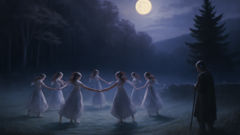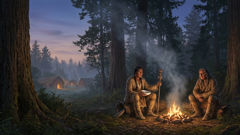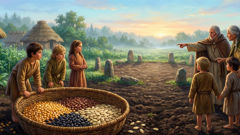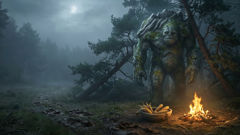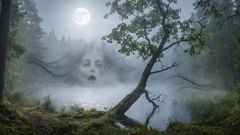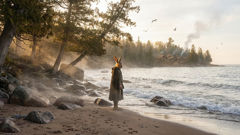Introduction
Beneath the high ribs of the Carpathians, where mist clings like a memory to rocks and the rivers speak in voices older than villages, there is a kind of listening that people learn by habit. They listen for the ordinary, for the first bark of the dog, the slide of a cart on gravel, footsteps that can be called by name. But there is another sound that demands a different keeping: the fragile, honeyed music of the Iele. For some this music is a promise of beauty so absolute it unseats reason; for others it is a road into ruin. In late spring and in particular nights of an autumn that refuses to let winter begin, when the moon hangs thin and relentless over the clearings, the Iele gather in hidden glades and on the south slopes beneath ancient beech and fir. They are called with many names across the region—iele, jir, hora-dancing spirits, mountain brides—but their work is the same. They dance until the earth remembers some older pulse; their skirts shape the grass into rings; their singing threads the air into something too bright and too sharp. The old keep their shutters nailed and their children at home. The curious become stories for the fireside. Out of these small, stubborn practices the villagers made a living map of avoidance and reverence that passed from mouth to mouth. This tale gathers those voices: shepherds and millers, healers and children, a man who heard the Iele in a lane by moonlight and survived, and the long human attempt to speak of what cannot be held. It is a tale about how music can be medicine and poison at once, about the way the landscape keeps its own laws, and about the bargains people learned to make when the dancing came under the moon.
1. The Call of the Iele
The first thing the old women said was simple and steady: the Iele do not live by our calendars. They live by moonlight and longing. They are not wholly of the wood and not wholly of the sky. In spring they step out of melting snowmelt and the exposed roots of old trees; in summer they ride the long white nights; in the brittle nights of an unexpected October they come to remember lovers they once were and griefs they refuse to forget. To the villagers the Iele are as real as the stables and the river and the last steep slope that marks the parish boundary. They are woven into the work of everyday life by rules and rituals that are small as a child's knot and as large as a village feast.
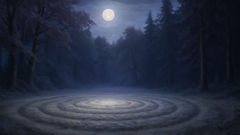
People spoke carefully about the Iele because speech itself is a kind of net. Names could either call them closer or set a boundary; so in some houses they refused to speak their full name, in other places they spoke a dozen different names to confuse whatever attention might be listening. The Iele are slender, said one teller, with hair like spilled ash and eyes that catch the moon; another said they are a sudden brightness in the dark, a throat full of silver. They dance with bare feet or with shoes of woven leaves, sometimes in pairs, sometimes in such crowded whirl that when you stand at the edge of the ring it is hard to see where one body ends and another begins. Their skirts take fire when they turn, or else remain cool to the touch, depending on who describes them. The villagers learned to listen for the shape of the sound: a breath that is first wind, then string, then a voice that is neither male nor female but carries both memory and accusation. The sound is not merely music; it is an instrument tuned to human desire. If you hear it and do not obey the rules of caution, it will unthread you the way a moth unpicks a hem.
There were rules, passed in the tone of homemaking rather than sermon. Never go out alone on a night when the moon is whole and white; never leave your infants with the wind; never follow a sound that moves too quickly across a field. If you found a ring of grass flattened into perfect circles, do not step into it, and do not call to those within. Some houses kept iron under the threshold or rags of garlic; others hung more particular tokens—an embroidered shirt pinned with a black thread, a small clay bowl left full of milk at the threshold. Milk, salt, embroidered cloth, a cracked mirror—each offering had its reason. The healers explained them as means to confuse or to focus, to distract or to bind the music, though the healers themselves often used a language of silence when they spoke of how the Iele took aim. Sometimes offerings would be left as if to pay a toll, a small bribe for forgetting. At other times a village would hold a vigil all night, drums and clapping and the complicated slow dances that are meant to keep the living steady and the line between the worlds intact.
The Iele took different things. Lovers—perhaps the most common—were their fare. Those in love, who walked at night humming to themselves, were magnets. The Iele's songs could make a listener laugh until his ribs ached and then hollow him out with longing until he slipped like a moth into a distant wood. They could recall a memory the listener did not know he had and make it burn so bright that the rest of life dulled. Some returned changed, touch-strafed and half-forgotten, eyes rimmed with a brightness that would never quite leave them. Others did not return at all and became part of the stories you tell to keep your children in their beds. Men who drove cattle past a certain glade swore they heard singing that made the hair on their necks stand up; women carrying bread home saw the flicker of skirts at the edge of their vision and hurried, holding the bread close as if to hide it. There were men who came back struck with silence; there were men who came back speaking only in rhymes and with a hunger for cold water. One healer told of a woman who returned after three nights and had forgotten her children's names.
But the Iele were not uniformly malevolent. The old tales also have tenderness. There are stories of gifts: a grain field that bloomed overnight after being cursed with drought, a lost lamb returned whole to a shepherd's fold, a woman who had been barren who dreamed of voices and woke with a child at her breast. These were bargains precarious and precise: help given only if the right token and the right time matched the favor. These exchanges, then, were not bargains with a god of moral law but with a being that kept its own economy of beauty and reparation. The currency could be a remembering, a tear, a false promise. Sometimes those who bargained were healed; sometimes they were reshaped.
Village rites grew complex around these truths. At marriages, some families would stitch a small scene of the Iele into the wedding cloth, both to honor and to appease. At funerals, songs were sometimes sung in a different key so as not to be mistaken by spirits as an invitation to dance. Children were taught to whistle a particular tune if they ever found themselves alone in a field at night; it was a tune that, by old rhyme and insistence, would make the Iele turn away, embarrassed by the simplicity of the sound. These are practical sorceries, small and often comic: the old leaders of the community were never ashamed to ask the universe to be less interesting if it meant keeping people whole. The depth of these practices shows how tightly the villagers wove their lives with the presence of the Iele, not as a passing menace but as a persistent law of the land that demanded attention and imagination.
The mountain itself kept the oldest books of the Iele. There are places where the ringed grass cannot be erased and where every child knows not to run. In the parish of Valea-unda, the shepherd Ion once told that his grandfather made a path of white stones across a meadow; no one dared remove them because on either side of the line the grass stayed green as if it had been blessed by someone who knew the scale of longing. In the south glades near the river, the Iele were said to dance with reeds, and when the reeds were taken from the riverbank the Iele followed like a rumor. These local geographies—ringed clearings, leaning stones, lone birches—became a kind of cautionary map in which memory and land keep each other. You do not cross without knowing what the land might answer. The Iele teach a patience about desire that is both fierce and small: a patience that asks humans to remember how to wait until the music becomes something they can live with or walk away from.
2. Encounters in the Moonlit Glade
The story that most of the parish recited by the fire was of Mircea the shepherd, who was not a man given to poetry or folly. He had small hands for mending nets and a slow smile that weathered like a fieldstone. Mircea's father and his father's father had driven sheep across the same ridges for generations, and the family name was trusted for miles. The summer Mircea was twenty-two the rains faltered and the lambing was lean. He stayed late with his flock more nights than he did in any year before, watching the teeth of the world sharpen. It was on one such late night, when the moon had risen fat and cold, that Mircea heard the first song.
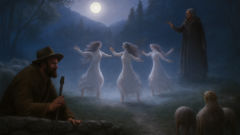
He thought it at first a lullaby carried by the wind. The tune was thin and bright, like water over quartz. It walked across the pasture in a way that made the hairs on Mircea's arm fine. He followed it because his feet took simple pathways, because curiosity is a thing that is fed by hunger, and because the world requires risk to be known. The grass changed underfoot; the air smelled of crushed mint and iron. As he rounded a beech, he saw them: pale figures whose movement made the tree leaves hush. They were not the crude shapes carved into shepherd's spoons. They moved like a language. His heart tightened—not with fear at first but with a sense that something had found him and found him lovely.
Mircea stepped back, as he had been taught, but the song pressed like a hand. One of the Iele glanced his way, and for a beat he felt recognized in a way that startled him: a naming. The Iele were laughing without mirth, and their laughter was precise, like a bell struck beneath water. His ears filled with fragments of old words—an old name of a lost lover of the mountain; the scent of his mother's bread. He did not go into the ring. He crouched, pressing himself against stone, and he watched. The dance wound on, skirts whipping the air, and he saw them shape the grass into circles that glowed faint as breathing lungs. A lamb three fields away began to bleat as if the sound of the Iele had formed from its mouth.
The moment that came next was small and awful. A young Iele—if the Iele can be called young—lifted a hand and tossed a strand of hair like a rope. It uncoiled across the light and settled on the stone where Mircea crouched. He felt its weight less as touch and more as memory. He thought of his mother and an unsaid apology. The song folded him like a letter. For a moment he experienced all the possible lives he might have had: a house full of children, a plain married with predictable griefs, a road where he had never taken his father's stead. He saw them as if a window had been opened in his chest. Tears came without his permission.
Then, a sound interrupted—the shouted name of an old woman, Baba Anica, who had been watching from the path, carrying her cane and the folded cloth she used to bind small wounds. She had been to the clearing before. She had seen the ring once in youth and had learned the tune to keep its attention from her. She called out not with anger but with the deliberate cadence of a woman who knows which rhythm counts. She whistled the simple counter-tune that every child learned, a tune that clipped the Iele's music like a comb through hair. The Iele blinked and the light changed. Mircea's memory unrolled like a map and fell to the ground. He stood up, shaking, as if someone had drained the warmth from his bones and returned it with a grudging hand. He could not remember the sound of laughter he had heard; he could feel only the memory of being sung to. Baba Anica pressed a bit of salt into his palm and spoke an old word that tasted of thyme. She told him to go home and spit into the soot of his stove three times and not to look back.
He obeyed. The next morning the villagers found him pale as new milk and his hair specked with white pollen. When they questioned him he could not name the Iele. He only said that he had been called and that some part of him had walked along the edge of forgetting for a time. He kept his hands at the hem of his shirt for weeks, as if holding himself by seam. Some said he had been touched; others said he had been lucky. Mircea married years later, and he had children who played in the fields, and no one said that the Iele had taken anything permanent from him. But the story did not end because it rarely does in these mountains.
There were other, darker tales. A miller in a neighbouring vale had been found at dawn standing at the river, humming a tune he could not stop. He drowned himself when the ice broke unexpectedly underfoot, people said, though others insisted there had been no ice at all. A group of boys chasing a fox came upon a ring at midnight and laughed to each other, daring. One of them fell into a trance and would not speak for three days. The trance left him with a new cadence in his voice, and his mother tied a red thread to his wrist until it faded with age. The point here is not to enumerate tragedies like a ledger but to show how the Iele's attention could be light as a feather or heavy as a stone. What makes a night benign or fatal is almost invisible: the health of the listener, the exact pitch of the moon, whether a token was placed on a window-sill that afternoon. The Iele's choices seemed to be shaped by an arithmetic of small things.
The healers had a language for these choices. They used plants and songs, and they read the direction of the wind. They watched the animals. When animals refuse to cross a certain spot, a human should not either. They used poultices of rue and rosemary, blackthorn twigs, and iron filings hidden inside a loaf. The cleanest remedy, some said, was a stitch in time: a community that watched together for several nights could blunt the Iele's aim. They would gather drums, and with measured beats they would commune in denial: if music forces you to attention, then louder communal music can dilute the invitation into ordinary noise. These were not superstitions but hard-earned civic practices that keep a population steady against an ecology of enchantment. The Iele remained part of the environment, like wolves or frost: not to be eradicated but to be known and negotiated with.
Mircea's tale became a teaching story. Young people told it when they tested boundaries, and mothers used it to remind their daughters why they must never leave home at the turning of the moon. But tucked between the edges of caution and fear was something else—an acknowledgment that the Iele remind you of an appetite too deep to be filled easily. They make you remember your own wanting. In that way they are a kind of moral mirror that does not lecture so much as reveal the nakedness of longing. The villagers learned to live with that truth: that some songs exist to show you what you most desire even when having it would break you apart. To live with the Iele is to live with a mirror you never asked for and cannot entirely turn away from.
3. Aftermath and Remembering
Time in the valleys is an honest thing; it remembers what you try to forget. After Mircea's brush the parish kept its own record, stitched into the edges of tablecloths and the hems of shawls and in the names people used for places. The ringed clearing became simply called 'La Hora' on maps made by people who trusted each other enough to write such things down. In winter the village elders convened over bowls of soup and argued the purpose of certain tokens—whether a single stitch of blue thread or an iron nail was more effective against the Iele's attention. They debated in the patient, repetitive way of people who have to prepare for danger not once but every season. The Iele were not an enemy to be fought and vanquished; they were an environment to be navigated and, to some degree, honored.
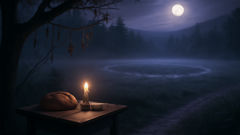
Generations performed these small negotiations differently. The nineteenth century brought new travelers and pious visitors who scolded folk practices as superstition, but the mountains refused to be lectured into pliancy. The Iele continued their dances in hidden places. Modern roads skirted some clearings and cut through others; sometimes a ring would appear on one side of the road and be gone the next season. In a surprising number of cases, the modern intrusions angered the Iele—perhaps because the new noises were clumsy or because the mountaintop changes were abrupt. There are accounts of automobiles stalling and radios failing when they approached a particular bend where the grass flattened in a perfect circle. These are the kind of stories that make engineers smile and villagers tighten the locks on their doors.
Yet memory is a living thing, and folk practice has an uncanny power to survive. A woman named Luminita kept a chest of objects: a shawl embroidered with an old dancer's motif, a clay cup blackened at the rim, a length of iron chain with a knot in the middle. She preserved them not out of superstition but as history: tokens of a people's negotiation with danger. She taught her grandchildren a song that was not the Iele's but a protective counter-song, one they would hum under their breath at night when the moon was thin. She told them how to look when they walked the ridge: not with curiosity that reaches out like a hand but with the careful recognition of someone who knows there are worlds that will accept or refuse you.
The living arts around the Iele took strange and powerful shapes. Artists from the towns came in search of images and found themselves sketching the lines of skirts and the ringed grass, always aware that any depiction was partial. The most successful pictures were those that captured absence as much as presence—an empty ring bleeding moonlight into the woods, footprints that lead to a place where no human foot could stand. Musicians wrote songs in compacts of dissonance that imitated the Iele's play between sweetness and edge. Poets learned to give the voice of desire a syntax that could hold both joy and danger at once. Even the county archivist, an efficient man, kept a small note about the clearing where lanterns sometimes burned in impossible patterns and where the local shepherds refused to graze after midnight.
There is also a part of this story that lives in the city, in the way folklore migrates with people. Emigrants from the valleys carried with them the stories of rings of grass and songs that unmade men. In small apartments they left tiny offerings on windowsills, more from habit than belief, and they taught their children to whistle a protective tune. The Iele, in these settings, become memory rather than presence, a way to teach children how to respect longing without being swallowed by it. In story and small ritual the people of the mountains kept the Iele alive and, through them, kept the mountains' lessons. Those lessons are blunt and sometimes contradicting: be wary of certain lights; listen to the animals; hold your promises; pay your debts to the land; learn the correct key for the right song.
But the Iele's persistence also asks a deeper question that hums beneath all the outward ritual: what does it mean to desire, and when does desiring become a harm? The villagers' answers are practical: rituals, tokens, and the communal vigilance of drums and clapping. But there are also softer answers, found in small kindnesses and in the recognition that some beauty is too bright for lasting life. The Iele do not authorize human griefs, but they make those griefs visible. Their songs sharpen what is already in a heart. To know them, then, is to learn the difference between a want that can be fed and a want that will hollow you out until you are a story told by others.
Over the years, the parish began to mark a few nights as times of controlled remembering. The community would gather at the hall and speak of the Iele in a voice that was neither shy nor mocking. They would tell the stories of the ones who were saved and of the ones who did not return, and they would leave a small table of offerings at the churchyard: bread, salt, a coin or two for the traveler. They framed the practice as a public act: a way to manage what cannot be managed alone. In that way, the Iele persisted not only as an omen but as a moral grammar that taught a people to listen carefully to both the land and to themselves. The ringed clearings remained ringed, the songs still sometimes lifted at odd hours, and the people learned to fold such events into the long business of living.
When modern scholars later tried to map the Iele into neat categories—nymphs, fairies, spirits—they frequently missed the lived texture of the tradition. The Iele are not simply symbols; they are demands. They demand attention, ritual and the slow, stubborn practices of a people learning how to keep child and animal safe. You cannot catalogue them without losing something important: the urgency of a song that can, in an instant, rearrange a life. So the best way to know them is through the layered stories of those who live under the same moon. That is why these tales persist: they are not merely fearful anecdotes but a kind of rural wisdom about living when the world you inhabit sings back at you with a voice that is beautiful and dangerous at once.
Conclusion
The story of the Iele ends not with a coda but with a practice. The people of the Carpathian valleys learned to weave the presence of the Iele into the ordinary clay of their lives: into songs hummed under breath, into the placement of iron in the hearth, into the little offerings left on thresholds. These are not mere rituals of fear; they are techniques for living with a landscape that calls back. The Iele remind us that some beauty carries a cost and that desire without boundaries can be a form of unmaking. Yet the story is also one of stubborn tenderness: villagers who refuse to abandon the land that holds both harvest and hazard; mothers who teach their children counter-songs; elders who stitch warnings into wedding cloth. In the end, the Iele remain as they always have been—unpredictable, luminous, and dangerous, a living thorn in the soft side of human longing. To speak of them is to place a map of caution in the hands of anyone who walks under the moon. That map will not keep one safe by itself; it only offers a language of attention. The Iele will keep dancing when the moon is right. We can keep our lanterns burning, learn the protective songs, and tell the stories that remind us which nights to stay home. And if, occasionally, someone hears a music so clear it unthreads the ordinary, there will be a chorus of voices to call them back: old women who know the whistle, friends who remember the counter-song, and a community that has learned how to listen and to protect what they love.

